Samsung Premiere LSP9T Review
Samsung successfully turns a high-spec, ultra short throw laser projector into a king-sized smart TV
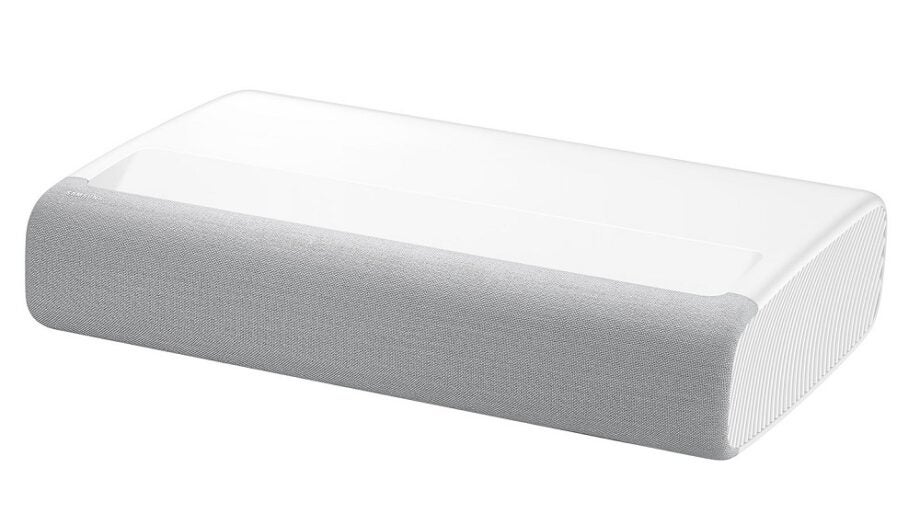

Verdict
No “lifestyle” projector to date does as good a job as the Samsung Premiere LSP9T of adapting to the massive variety of conditions you get in a typical living room. So while it isn’t flawless, if you want something that resembles a 130-inch TV without paying the tens of thousands of pounds an actual 100-inch+ TV would cost, Samsung’s unexpected projector hero is as good as it gets.
Pros
- Remarkably bright, colourful pictures
- Compact, living-room friendly design
- Built-in tuner and TV-like smart system
Cons
- It’s not cheap for this sort of projector
- Loss of colour finesse in very dark scenes with certain presets
- Rainbow effect
Key Features
- Built-in tuner and Eden smart system
Introduction
Not content with being the world’s biggest TV brand, Samsung now wants a slice of the home cinema projection pie, too, with the Samsung Premiere LSP9T.
And with its ultra-short throw laser optics, built-in “TV” smart system, powerful speakers, 4K resolution and wide-ranging HDR support, the £6999 Premiere LSP9T certainly makes a statement.
Availability
- UKRRP: £6999
- USARRP: $6499
- EuropeRRP: €6399
- CanadaRRP: CA$8999
- AustraliaRRP: AU$10999
The Premier LSP9T was released late 2020 for the price of £6999 / $6499 / €6536 / CAD$8999 / AUD$10,999.
Note, that the LSP9T isn’t Samsung’s only new Premiere projector. You can also get the Premiere LSP7T, which uses a single laser/colour wheel light system, resulting in reduced colour range and brightness. That’s available for a less eye-watering £3999.
Design
- Quite large
- Built-in speakers
- Good build quality
The Premiere LSP9T is carefully designed to be a “lifestyle” projector – one that can fit comfortably into a normal living room environment.
Its ultra-short throw optical system means you can leave it permanently sat on a sideboard, for instance, tucked right up against your wall, while its polished white finish looks much easier on the eye than the typical hulking black projector box.
The Premiere LSP9T is still quite large by living room projector standards; the laser array and UST optics do need some room for manoeuvre, after all. Thanks to its rounded corners, however, plus its gleaming finish and the softening effect of the felt-speaker covers on its rear (which is actually the bit that faces into the room), it wears its size well.
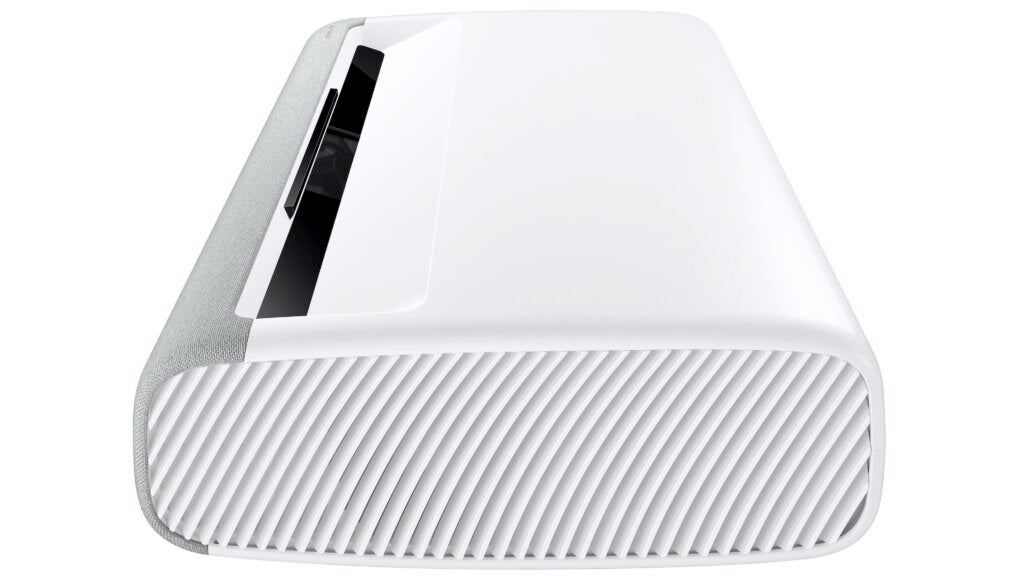
The Premiere LSP9T isn’t the first projector to carry built-in speakers. Most “casual” models do, these days. The LSP9T goes way further than most, tucking a 40W, 4.2-speaker system behind that felt cover. This provides us with the biggest hint that Samsung wants the LSP9T to deliver an experience that feels like watching a truly king-sized TV.
Pictures emerge through a slit in the projector’s top edge, while connections sit on the edge that sits nearest the wall. This makes it easier to hide cable spaghetti – although the projector can sit so close to the wall that it can be tricky to fit inflexible high-quality cables into the available space.
Unusually, the LSP9T’s white colour scheme continues to its attractive remote control. In the main, it successfully limits the number of buttons it carries, without compromising day-to-day functionality or leaving you feeling confused about what button does what.
Features
- 2800 lumens of brightness
- 20,000 lifespan
- First projector with HDR10+ support
Laser-based lighting projectors such as the LSP9T offer a number of lifestyle benefits. First, they can deliver enough brightness – a claimed 2800 lumens in the LSP9T’s case – to produce watchable pictures even in fairly bright rooms. They can also deliver richer, bolder colours, which again helps images hold up against ambient light.
The LSP9T goes the extra mile in this respect by using a triple (RGB) laser system, so that there’s no need for the laser’s light to have to run through a colour wheel of the sort found in typical affordable DLP projectors. As a result, Samsung’s projector claims to cover a remarkable 106% of the extreme BT2020 HDR colour gamut, and 147% of the DCI-P3 digital colour system typically used in commercial cinemas.
Its laser array also lets you turn the projector on and off almost instantly, without the usual inconvenient warm-up and cool-down times. And unlike regular lamp projectors, there’s no need to replace bulbs every 2000-5000 hours. In fact, the LSP9T’s laser is claimed to be good for 20,000 hours, which is enough for 10,000 two-hour films.
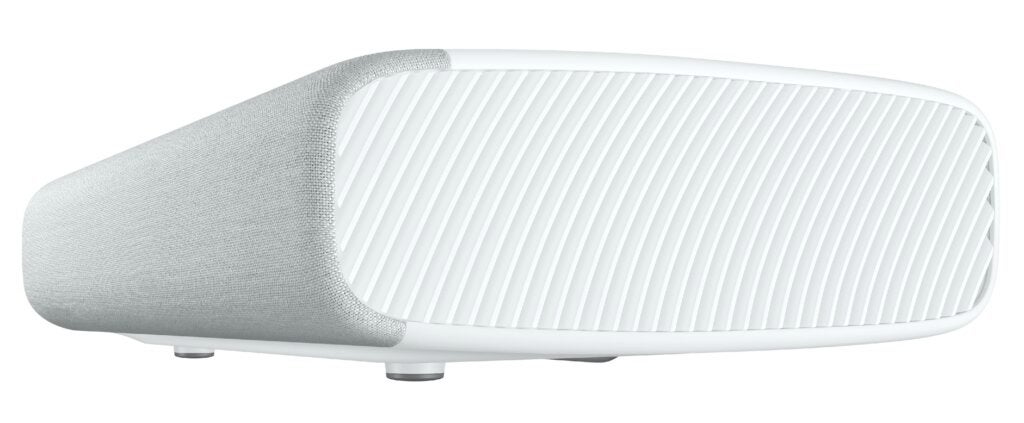
Connections are headlined by a Freeview HD tuner input (built-in tuners are extremely rare in the projector world) and three HDMIs, all capable of 4K HDR at up to 60Hz frame rates. There’s no support for the latest gaming features of 4K HDR at 120Hz or variable refresh rates – but then no rival projector supports such features, either.
However, the LSP9T does support eARC, so you can pass Dolby Atmos audio over HDMIs. There’s a projector world first, too, in the shape of support over HDMI or streaming for the HDR10+ HDR format. This adds extra scene-by-scene data to basic HDR10 video streams, to help displays deliver more dynamic results. The HLG broadcasting HDR format is supported too.
There isn’t support for the similar Dolby Vision system, but Samsung doesn’t support that on any of its display devices. And nor, so far, do any other mainstream projectors support Dolby Vision either.
Remarkably, considering how closely it can get to your wall, the LSP9T can give you an image as big as 130 inches from corner to corner. And while its 4K resolution isn’t truly native, the double-flashing DLP technology it uses to create a pseudo-4K effect is convincing enough to have persuaded the US Consumer Technology Association to denote it as real 4K.
Tucked under that striking grey felt on the LSP9T’s back is the most innovative audio system ever built into a projector. As if its 40W into 4.2 channels wasn’t already impressive enough, it also uses Acoustic Beam technology, where 44 separate output points are used to enhance the sound’s left and right dispersion.
Basic setup is easy, to the extent that you don’t have the usual zoom and image-shift tools to worry about. You just plonk the LSP9T on your sideboard and that’s it. Getting the image’s geometry right via a set-up screen that uses no less than nine different adjustment points can become quite involved, however. Also, if you’re using a screen (as I’d recommend) rather than just your wall, you’ll also need to hang this screen very carefully in relation to the projector’s position to ensure the picture appears in the correct position.
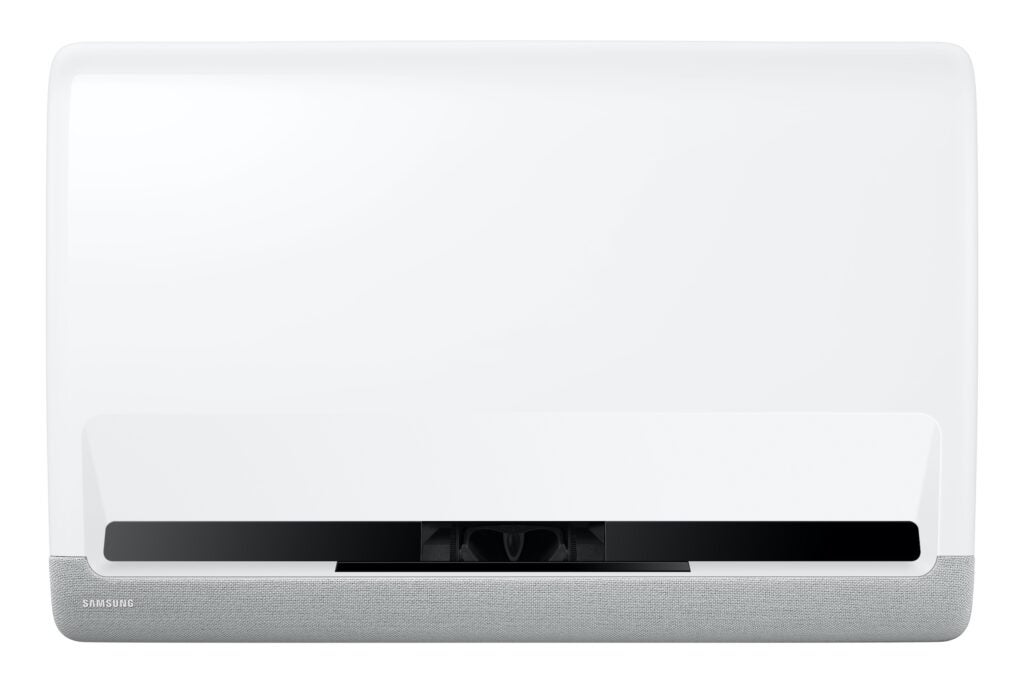
Unlike most projectors, you’ll definitely want to get the LSP9T networked to your Wi-Fi. This is because it features a full (if slightly sluggish) version of the Eden smart platform you get on Samsung’s TVs. Complete with all the same video-streaming apps and even built-in voice control.
The only annoying thing here is the way you have to sign up for a Samsung online account before you can install apps such as Netflix or Amazon Prime.
Since the LSP9T supports HDR10+, it’s the first projector that’s able to take advantage of Amazon Prime’s support for this HDR format. It’s also uniquely good at wirelessly connecting with and streaming stuff from other devices thanks to built-in support for Apple AirPlay 2, screen mirroring for both Android and Apple devices, and even Tap Play, where you can connect a Samsung Galaxy phone just by touching it against the projector’s bodywork.
Performance
- Vibrant, colourful images
- Good performance in bright/dark rooms
- Better than expected audio from its speakers
The Samsung Premiere LSP9T certainly knows how to make an entrance. Its pictures are the most vibrant I’ve seen from any projector – including ultra high-end “light cannons” costing many times more. The combination of 2800 lumens of laser output, the absence of a colour wheel, and the triple laser’s remarkably vibrant, pure colours add up to images that transcend projector expectations to end up looking like what Samsung wants them to look like: TV pictures.
The colour performance is particularly exceptional. For while there are projectors out there that can – or claim to – deliver more brightness than the LSP9T, I can’t think of any for the LSP9T’s sort of money that can combine that brightness with such a blazing range of colours. There’s a real volume to its colour performance that unlocks the wide colour/high dynamic range combination found on 4K Blu-rays and HDR streams spectacularly effectively.
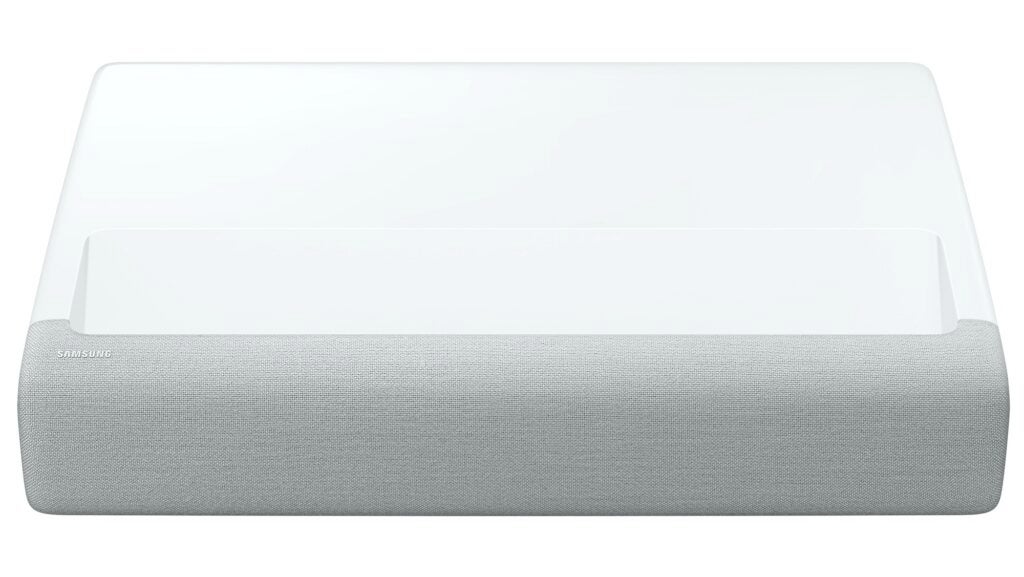
Wide colour gamut projectors normally have to apply a filter to live up to their wide colour claims – a filter that inevitably heavily reduces brightness, thereby compromising colour volume. With the LSP9T, though, the laser system’s extreme brightness and pure, untrammelled, colour wheel-free hues and tones emerge unimpeded.
What’s more, since the projector sits so close to your wall or screen, there’s less distance for its impact to be reduced by ambient conditions. So while its images are at their most dazzling in a dark room, they’re still remarkably bold, detailed and engaging even if there’s lots of ambient light around.
Not surprisingly, the LSP9T’s Bright picture preset that works so well for bright rooms is a bit much for serious dark-room viewing. However, the Standard mode offers a good – although you might want to crank up colour a touch more – dark room compromise between Bright and the more accurate but also much flatter Movie and Filmmaker modes.
The LSP9T’s pictures are seriously detailed and sharp. This is especially true with native 4K sources, with which Samsung’s projector gives the clarity and density of Sony’s SXRD projectors a run for their money. This is especially impressive given that the LSP9T is an ultra-short throw model, where achieving pristine focus right across the image is a real challenge.
The clarity holds up nicely even during action scenes, sports events and camera pans, thanks to some of the most effective motion processing I’ve seen on a projector. This lets you massage away excessive judder without leaving the picture looking too processed or overly smooth.
More apparent helpful crossover from Samsung’s TV division comes in the form of some excellent, pretty much pristine handling of HD sources.
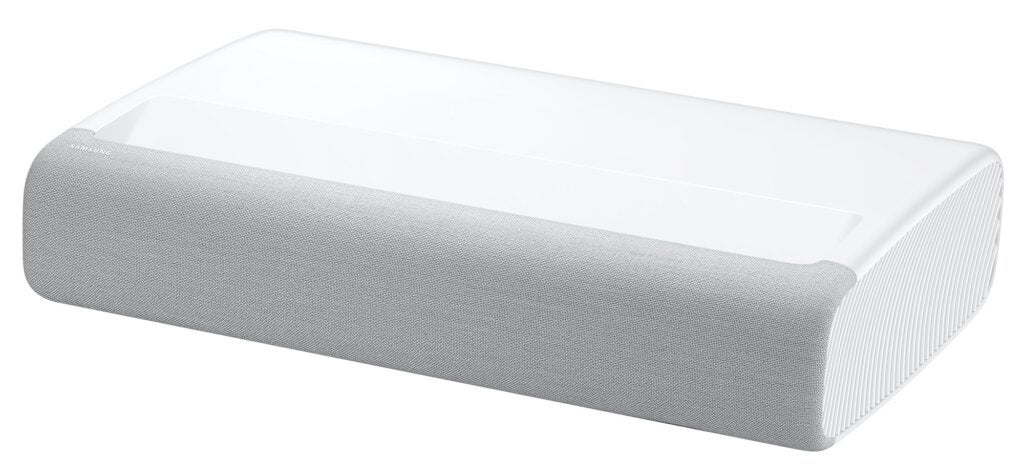
While laser projectors can be impressive with brightness and colour, they can struggle with contrast and black level. Samsung has tried to get round this with a Dynamic Black feature. This boosts the bright parts of dark scenes, while simultaneously reducing the laser’s light intensity to improve black levels.
It works quite well on the Bright and Standard presets, giving decently deep black levels – at least in the context of the extremely bright, colourful content they’re appearing alongside. Black levels still look solid using the these two presets, even in a fairly bright room.
It’s perhaps a pity that the Dynamic Black feature works only automatically, and can’t be adjusted manually. Especially when it comes to the Movie and Filmmaker mode presets, where the feature seems to be working much less aggressively, resulting in noticeably greyer dark areas that contribute to much flatter-looking images in general.
The LSP9T is the first projector to carry the Filmmaker Mode. This has been independently assessed/designed by the UHD Alliance to meet its criteria of delivering pictures that get as close as possible to the standards used in movie industry mastering suites. Personally, the extent to which Filmmaker Mode reins in the LSP9T’s colour and flattens its contrast doesn’t feel entirely convincing in the context of this sort of projector. It’s also very similar to the Movie mode, when maybe a bit more difference between the two would have been useful.
That said, it’s pretty much unheard of to see a lifestyle projector going so far as the LSP9T to try to cater for serious home theatre fans and room setups, as well as more casual, bright room conditions. So while I personally wasn’t particularly drawn to the Filmmaker Mode, I’m still glad it’s there.
While typically brilliant (literally), there are a couple of peculiar issues with the LSP9T’s pictures. First, they suffer with the so-called rainbow effect. This sees stripes of pure colour sometimes flashing fleetingly over very bright highlights of high-contrast pictures. It’s an unexpected find here because, typically, it’s associated with DLP colour wheels – yet the LSP9T doesn’t use a colour wheel.

The other issue is that while colours look as subtly toned as they are spectacular during bright scenes using the Bright or Standard picture presets, oddly, the subtlety can drop off quite dramatically during very dark scenes. Tones can suddenly start to look quite basic and short of nuance. Skin becomes quite plasticky, for instance, and objects appear flatter.
This problem completely disappears if you switch to the Movie or Filmmaker mode presets. Here, colours retain their finesse right across the brightness spectrum. But you lose much of the colour intensity and brightness that typically make the LSP9T’s pictures so attractive in its other two presets.
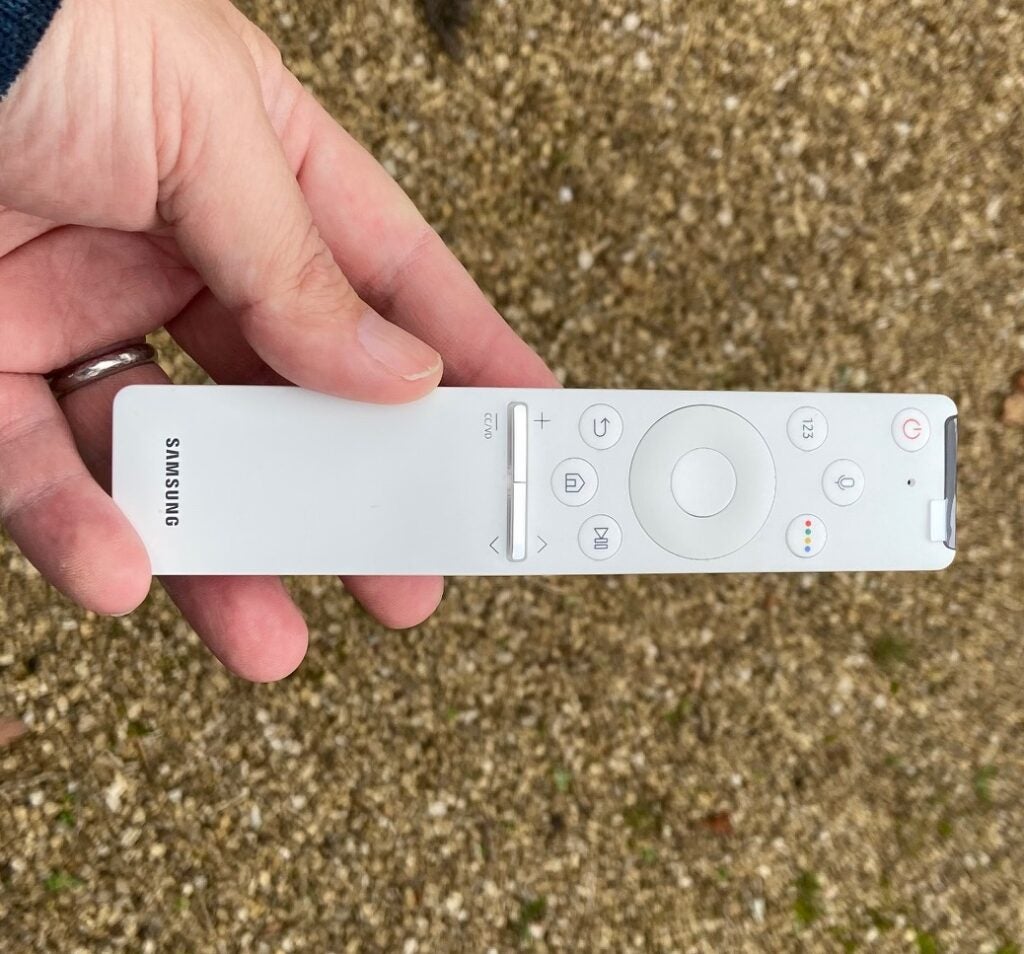
The LSP9T’s built-in speaker system is a revelation by projector standards. Its sound spreads far beyond the physical confines of the projector’s bodywork, achieving a scale that feels like an appropriate match for the epic size of its pictures. There’s lots of detail to be heard, too – but none of this sounds too bright or harsh.
Voices are convincing and appear slightly elevated vertically, so that they “belong” to the pictures above the projector. The mid-range is expansive and dynamic. Bass is, maybe inevitably, a little restrained and limited in depth, but it’s still good enough not to leave even action movie soundtracks feeling unbalanced or thin.
In short, the LSP9T sounds much more like a TV – or even a soundbar – than a typical living room projector.
Should you buy it?
You’re after a TV replacement The thing to bear in mind about the Premiere LSP9T is that it has more in common with a huge TV than a typical home cinema projector.
You’re looking for a dedicated home cinema projector If you’re looking for a projector for a dedicated home cinema room, you could get a more satisfying all-round option elsewhere for less money. I’m thinking in particular of the £6495 JVC DLA-N5, or the £4999 Sony VW270ES.
Verdict
No “lifestyle” projector to date does as good a job as the Samsung Premiere LSP9T of adapting to the massive variety of conditions you get in a typical living room. So while it isn’t flawless, if you want something that resembles a 130-inch TV without paying the tens of thousands of pounds an actual 100-inch+ TV would cost, Samsung’s unexpected projector hero is as good as it gets.







